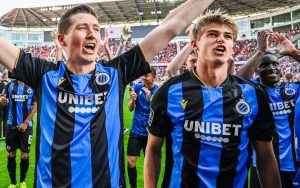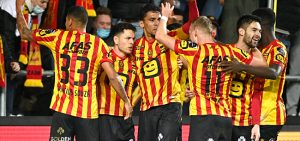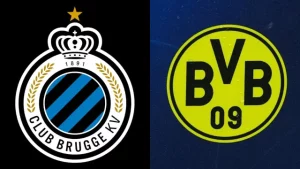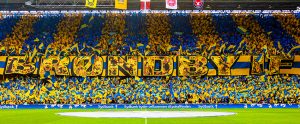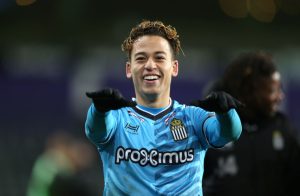
What if… Jim Harbaugh became head coach at Michigan after Lloyd Carr?
That’s part of the intro to Marvel’s “What If…?” series on Disney+, the inspiration for what will be an offseason series contemplating a world where things happened differently in college football and in Ann Arbor in 2023.
Just like the Avengers conquering Thanos and restoring half of the universe’s population, Michigan was victorious over all of college football this past season.
We’ll explore worlds where things happened differently. Sometimes, the result of a championship will be the same, just in different ways. Other realities are much more grim. Maize n Brew will guide you through these realities and ponder the question, What if…
Institutions fall when leadership struggles. Your timeline witnessed that when Lloyd Carr retired in 2007. It opened the doors to nearly a decade of insignificant football in Ann Arbor, a depleted football program and fanbase, and the need for monumental changes.
/cdn.vox-cdn.com/uploads/chorus_image/image/73370925/usa_today_8309073.0.jpg)
Jim Harbaugh succeeded in restoring the greatness at Michigan after nine seasons, winning the 2023 National Championship. It took years to re-establish the hard-nosed toughness the Wolverines once possessed, and it led them to being champions once again.
But what if there was never a need to fully restore the program? Let’s explore a timeline where an up-and-coming head coach with ties to the Michigan Wolverines came to Ann Arbor much sooner than your world.
It’s early 2007, and Lloyd Carr’s Wolverines had just lost their two most important games to end the 2006 season. Most frustratingly was The Game, where No. 1 Ohio State topped No. 2 Michigan in Columbus. They answered that game with a loss in the Rose Bowl to No. 8 USC, where the offense scored just three points in the first three quarters of action. It was the most disappointing finish imaginable for the Wolverines, and there was pressure on the administration to make a change sooner rather than later.
In this universe, Michigan and Lloyd Carr agreed to mutually part ways, as Carr retired in early 2007 instead of after the fall season of the same year.
This opened the door for a coaching search where Michigan still had some of the top players remaining on their roster, specifically on the offensive side. A core of Chad Henne, Mike Hart, Mario Manningham and Jake Long made Ann Arbor one of the top coaching jobs on the market.
While there were plenty of options available, Michigan had its eyes set on a former player who had been dominating the Division II level. Jim Harbaugh had taken the University of San Diego to consecutive 11-1 records and led Division II football in points per game, passing yards per game, total yards per game and first downs per game. The Toreros’ starting quarterback, Josh Johnson, threw for 67 touchdowns and 6,201 yards in the final two years under Harbaugh. Michigan was intrigued by what that could mean for Henne and top recruit Ryan Mallett.
The two sides agreed to a deal that shocked many pundits across college football. A Division II coach taking over a team with championship aspirations was a surprising move, but Michigan liked bringing an alum back to Ann Arbor.
The 2007 season opened against Appalachian State, a team that beat the No. 5 ranked Wolverines in your timeline for what would be the ugliest loss in Michigan history. But with Harbaugh and a new swagger to the Wolverines’ step, they trounced the Mountaineers to open the season for Harbaugh’s first win in the Big House.
However, the remainder of the season still wasn’t completely up to snuff. The Wolverines lost a close one to Oregon the next week and finished with three losses in Harbaugh’s first season as a Division I head coach. Despite this, optimism was still high from the perspective of the administration.

One of the most important components of the coaching change was Harbaugh wanted to continue the tough-nosed approach to football. There was never a full philosophical change on the offensive end that saw the spread offense and quarterback runs; Michigan football remained Michigan football under Harbaugh.
While Michigan still lost Mallett to a transfer, the Wolverines plucked Andrew Luck, a top-50 recruit in the 2008 class, out of the jaws of Texas. He’d be the starter for the Wolverines as a true freshman. Brandon Graham’s emergence at defensive end in 2007 also drew in success on both sides of the ball moving forward. The team won eight games in a reloading season in 2008, then won nine games in 2009, and 10 games in 2010.
Without a significant drop off, like in your universe, Michigan continued to out-recruit Mark Dantonio and Michigan State. Harbaugh and the Wolverines had a strong record against their in-state rival. While there were some struggles against the Buckeyes, there was never more than a three-year period where Michigan went winless against its largest of foes.
Everything came together in 2011, Luck’s final season in Ann Arbor. He’d thrown for more than 3,500 yards for the Wolverines and threw 35 touchdowns to just eight interceptions. Luck was the top name for the NFL Draft, similar to your world. At a much larger school, however, Luck was named the Heisman Trophy winner over Robert Griffin III at Baylor.
With the help of 1,000-yard rusher Fitzgerald Toussaint, the Michigan offense was one of the most potent in college football and had a defense that turned heads with toughness, physicality and blitzes from all over the field. With wins on the resume against Notre Dame, Michigan State, Nebraska and Ohio State, the Wolverines were ahead of the BCS metrics to earn a spot in the National Championship over the Alabama Crimson Tide, a team that only lost one game.
It would be No. 1 LSU vs No. 2 Michigan for the national title. A sloppy start from LSU with a fumble on the opening drive set the tone for the game, as Michigan leaned on kicker Brendan Gibbons in a defensive battle — the star kicker knocked four field goals through the uprights.
Michigan’s offense under Luck was just good enough to keep putting the Wolverines in position to put points on the board, and LSU was unable to keep pace. Michigan would win the National Championship in year four under Harbaugh, cementing himself as one of the best coaches in college football at such an early stage in his career.
Without ever sniffing the NFL, as he did with the San Francisco 49ers in your timeline, Harbaugh’s focus remained in Ann Arbor and building a dynasty. A run began between the Big Ten, SEC and ACC. But it was not Ohio State, Clemson and Alabama — instead the Wolverines took that slot. Harbaugh vs. Saban became one of the greatest coaching rivalries in all of college football, especially as the College Football Playoff era began in 2014 and the two sides met even more often.
Michigan won multiple championships under Harbaugh, and their success continued even to the present day of where this timeline and yours meet. The Wolverines won the National Championship for the fourth time in the Harbaugh era in 2024, and the dynasty in Ann Arbor’s story is still being written.
